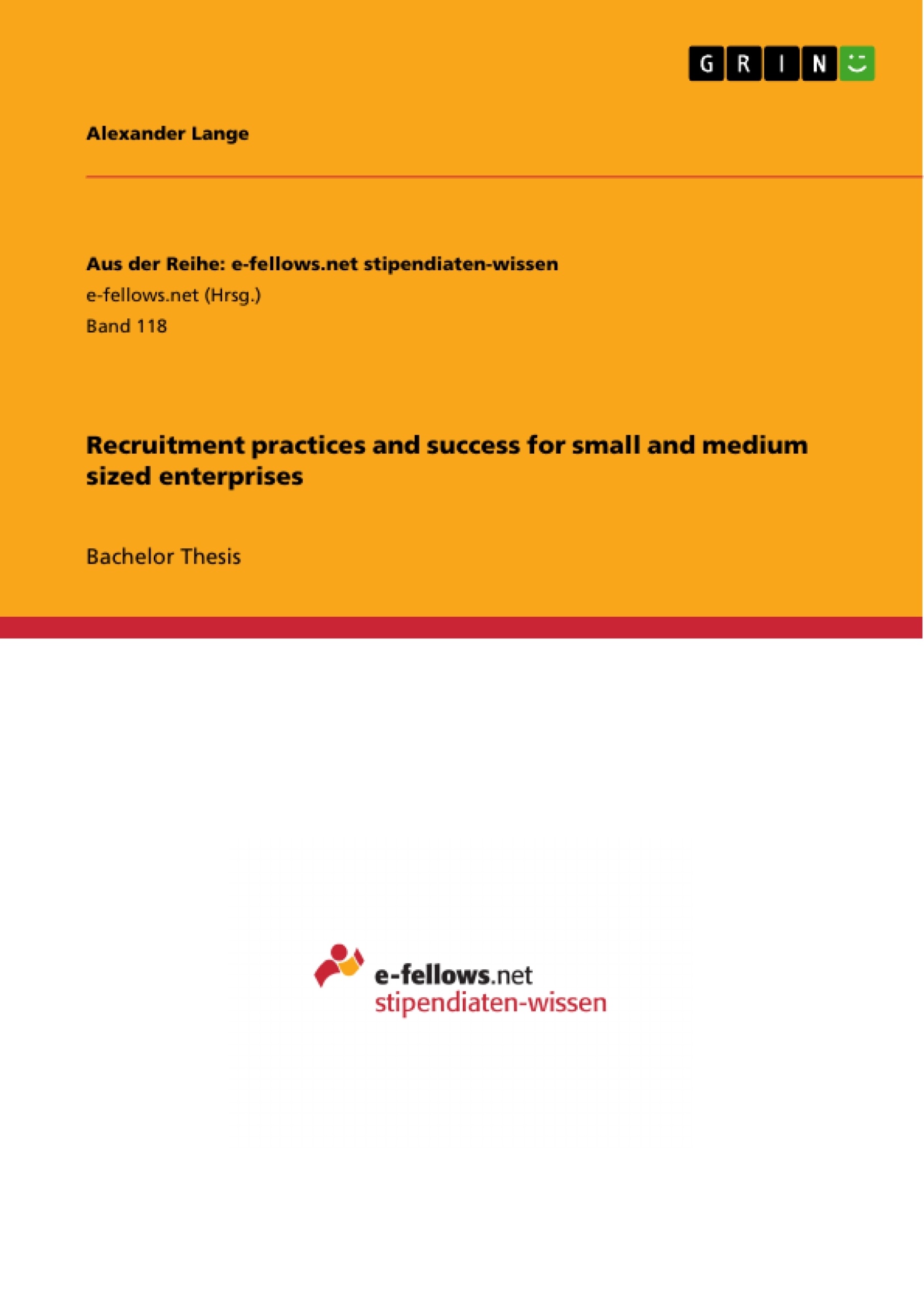This study observes the effects of different recruitment practices of SMEs on quantitative and qualitative recruitment outcomes. Thereby the concepts of Person-Organizations (P-O) fit and Person-Job (P-J) fit are introduced with regards to qualitative outcome measures. The examined practices include traditional forms of recruitment such as network recruitment, but also relatively new constructs such as strategic isomorphism. Results reveal that recruitment practices differ in their influence on applicant pool quantity and quality. It is found out that a specific recruitment source either influences quantitative or qualitative recruitment outcomes, but hardly both.
The findings also show that SMEs use different approaches when recruiting graduate or non-graduate students. Further, practices vary in their effectiveness on these two target groups. Network recruitment, for example, was able to enhance the P-O fit of graduate applicants, but had no effect on the fit of non-graduate applicants.
Inhaltsverzeichnis (Table of Contents)
- ABSTRACT
- INTRODUCTION
- PREVIOUS RESEARCH ON RECRUITMENT CONDITIONS FOR SMES
- THEORETICAL FRAMEWORK
- Signaling Theory
- Person-Organization Fit
- HYPOTHESES
- METHODOLOGY
- Sample
- Data Collection
- Data Analysis
- RESULTS
- Recruitment Practices and Applicant Pool Quantity
- Recruitment Practices and Applicant Pool Quality
- Recruitment Practices and P-O / P-J Fit
- Recruitment Practices and Applicant Group
- DISCUSSION
- Practical Implications
- Theoretical Implications
- Limitations and Future Research
- REFERENCES
Zielsetzung und Themenschwerpunkte (Objectives and Key Themes)
This study aims to investigate the impact of different recruitment practices employed by small and medium-sized enterprises (SMEs) on both quantitative and qualitative recruitment outcomes. It explores the relationship between recruitment practices and the concepts of Person-Organization (P-O) fit and Person-Job (P-J) fit, examining the influence of various recruitment methods on perceived fit. Additionally, the study analyzes the effectiveness of recruitment practices for attracting different applicant groups, specifically graduate and non-graduate students.
- The effects of different recruitment practices on applicant pool quantity and quality.
- The relationship between recruitment practices and the concepts of Person-Organization (P-O) fit and Person-Job (P-J) fit.
- The effectiveness of recruitment practices in attracting graduate and non-graduate applicants.
- The specific challenges and opportunities faced by SMEs in the recruitment process.
- The contribution of Signaling Theory and Person-Organization Fit to understanding recruitment strategies in SMEs.
Zusammenfassung der Kapitel (Chapter Summaries)
- ABSTRACT: Provides a concise overview of the study's objectives, methodology, and key findings. The abstract highlights the relationship between recruitment practices and applicant pool quantity and quality, and explores the concepts of P-O and P-J fit in relation to recruitment outcomes.
- INTRODUCTION: Introduces the importance of human resources in achieving competitive advantage for SMEs, emphasizing the need for effective recruitment strategies. The chapter also discusses the unique challenges faced by SMEs in attracting talent and the limitations of existing recruitment research on SMEs.
- PREVIOUS RESEARCH ON RECRUITMENT CONDITIONS FOR SMES: Reviews existing literature on the specific conditions that SMEs face in the recruitment process, emphasizing the differences in financial, structural, and personnel resources compared to larger firms. The chapter highlights the challenges SMEs encounter in implementing efficient recruitment processes due to these limitations.
- THEORETICAL FRAMEWORK: Explores the theoretical frameworks of Signaling Theory and Person-Organization Fit, outlining their relevance to understanding recruitment strategies in SMEs. The chapter discusses how job seekers interpret organizational signals and the importance of aligning individual values and organizational culture for successful recruitment.
- HYPOTHESES: Presents a series of hypotheses based on the theoretical framework, outlining the expected relationships between recruitment practices, applicant pool size, applicant quality, and perceived P-O/P-J fit. These hypotheses are further specified for different applicant groups (graduates and non-graduates).
- METHODOLOGY: Describes the research methodology employed in the study, including the sample selection, data collection methods, and data analysis techniques. The chapter outlines the procedures used to test the formulated hypotheses and gather evidence to support the study's findings.
Schlüsselwörter (Keywords)
The study focuses on recruitment practices in small and medium-sized enterprises (SMEs), examining their impact on applicant pool quantity and quality. Key themes include Signaling Theory, Person-Organization (P-O) fit, Person-Job (P-J) fit, strategic isomorphism, network recruitment, graduate and non-graduate applicant groups, and the challenges and opportunities faced by SMEs in the recruitment process.
- Citar trabajo
- Alexander Lange (Autor), 2010, Recruitment practices and success for small and medium sized enterprises, Múnich, GRIN Verlag, https://www.grin.com/document/175337



